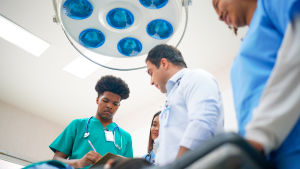In this article we will talk about the design thinking method, what its application phases are, and how it can help your organization!
At all times, the job market and customer needs are constantly changing, and it is necessary to innovate and use creativity to meet the demands. However, this need for constant innovation can be a bit tricky, because being innovative and creative all the time is somewhat challenging.
But calm down, all is not lost, for it is at this stage that design thinking can be used to help you in these moments. The design thinking is a tool that helps stimulate innovation from creative thinking, with the goal of finding different methods to solve diverse problems.
The technique arose in the designer’s field, but it can expand to any area, because its goal is to use empathy and creativity to meet the needs of its clients and create solutions in an innovative way.
So, without further ado, let’s better understand what the real purpose of this tool is and what are the steps we can follow to apply them in organizations effectively.
What is design thinking?
The design thinking, something we translate as “designer thinking,” translates as an approach that proposes using different methods to solve problems, optimizing their time and their results.
The idea is that everyone involved, in a collaborative way, seeks creative solutions to issues that aim at customer satisfaction. But even though it is a concept that emerged in the designer’s field, this approach goes beyond this aesthetic and can be applied in any organization.
This is because it is a functional, efficient approach that seeks to make a difference in people’s lives. Helping, of course, that behind every process, the team comes up with innovative solutions.
In design thinking there is no specific formula on how to implement it. It enables conditions for generating insights. Your goal being to accomplish this as a team to gather as many different perspectives as possible.
How can design thinking be applied?
All organizations are free as to the method of applying this approach, as each company has different needs, and adaptations to the process are necessary. But there are some essential pillars to know before starting any process, they are:
- Empathy: trying to see the problem through the eyes of the people who are experiencing it. In many cases it would be to take a more empathetic view of your customers and understand what their complaints and pains are.
- Collaborate: the design thinking proposes that everyone is involved to generate as many ideas as possible, thus collaborating in the search for solutions and achieving more scope.
- Experiment: This approach is about something practical, that is, ideas must be tested to ensure their effectiveness.
Moreover, one of the most common questions is how to actually apply design thinking effectively, since it can seem somewhat abstract to think only about the concepts. To do this, you need to follow some steps of the approach and understand how this concept can be applied. There are a total of 5 steps to be analyzed.
What are the 5 phases of design thinking?
By following these phases below, it may be easier to identify how the goal of the approach is to make the customers’ experience and need be valued throughout the process. Let’s see.
1 – Immersion: empathy with your clients
This is related to one of the pillars of the approach. For it is about the empathy you must have with your audience and understanding what their needs are. Here is the moment where you and your team will put yourself in your clients’ shoes, understand what their interests are, what their difficulties are, understand what their needs are, and what is the best way to meet them.
Having empathy is a very important key. At this stage, all obstacles are identified and those responsible need to have an open mind to understand the demands well.
2 – Definition: define which problems must be solved
With all the information you collect during the first phase, you will define what the main problem to be solved is, and define ideas for possible ways to solve it.
It is necessary to list what the priorities are and to get together with the team to gather ideas. You need to identify what the indispensable needs of the audience are and ways to solve them.
3 – Ideation: idea gathering
At this point you will actually put into practice and talk with the team what can be accomplished. So far you have understood what the problems are and which ones should be a priority, now it is time to think about how to solve them.
It is important to remember that at this moment everything is valid and important. This is a moment of brainstorming, where all ideas are welcome. The ideas should flow and everyone involved should participate with suggestions, nothing should be ignored. Thus, the process becomes more effective and collaborative.
4 – Prototyping: this is the moment of simulation!
This is the phase where the ideas raised so far will be put into practice. After selecting the best solution for the initial problem, it is time to simulate whether the service or even the product would be effective if implemented.
It is very important to perform tests, create prototypes and simulations so that possible errors can be identified and treated before being made available to the public.
5 – Validation and implementation: the time to validate your tests and put them into practice
Finally, the last step! This is the time to really put into practice all your tests carried out so far and observe what the feedback from your audience will be. At this stage it is still possible to make the necessary changes to deliver what your customer needs, further optimizing your product or service offering.
For the implementation to occur effectively, it is necessary to show what was developed, what the differentials and advantages are, so that the public understands how much that was thought and planned exclusively.
Why use design thinking?
Applying design thinking can help you better understand what your customers’ expectations and needs are, and what they expect from your company.
The organization that cares about knowing what the customer’s problems are and bringing solutions for them will be a highlight in the market, because it demonstrates how much it values its public. And more than appreciation, the public and those involved in the process feel more integrated, stimulating more empathy and collaboration.
Finally, design thinking can be very efficient for those who are looking for methods on how to find answers to the most relevant questions in their business. Did you get a general understanding of what this approach is about, which through innovative solutions seeks to optimize your processes and improve your management?










